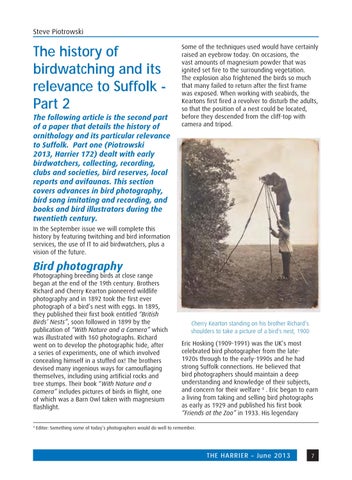Steve Piotrowski
The history of birdwatching and its relevance to Suffolk Part 2 The following article is the second part of a paper that details the history of ornithology and its particular relevance to Suffolk. Part one (Piotrowski 2013, Harrier 172) dealt with early birdwatchers, collecting, recording, clubs and societies, bird reserves, local reports and avifaunas. This section covers advances in bird photography, bird song imitating and recording, and books and bird illustrators during the twentieth century.
Some of the techniques used would have certainly raised an eyebrow today. On occasions, the vast amounts of magnesium powder that was ignited set fire to the surrounding vegetation. The explosion also frightened the birds so much that many failed to return after the first frame was exposed. When working with seabirds, the Keartons first fired a revolver to disturb the adults, so that the position of a nest could be located, before they descended from the cliff-top with camera and tripod.
In the September issue we will complete this history by featuring twitching and bird information services, the use of IT to aid birdwatchers, plus a vision of the future.
Bird photography
Photographing breeding birds at close range began at the end of the 19th century. Brothers Richard and Cherry Kearton pioneered wildlife photography and in 1892 took the first ever photograph of a bird’s nest with eggs. In 1895, they published their first book entitled “British Birds’ Nests”, soon followed in 1899 by the publication of “With Nature and a Camera” which was illustrated with 160 photographs. Richard went on to develop the photographic hide, after a series of experiments, one of which involved concealing himself in a stuffed ox! The brothers devised many ingenious ways for camouflaging themselves, including using artificial rocks and tree stumps. Their book “With Nature and a Camera” includes pictures of birds in flight, one of which was a Barn Owl taken with magnesium flashlight. 4
Cherry Kearton standing on his brother Richard’s shoulders to take a picture of a bird’s nest, 1900
Eric Hosking (1909-1991) was the UK’s most celebrated bird photographer from the late1920s through to the early-1990s and he had strong Suffolk connections. He believed that bird photographers should maintain a deep understanding and knowledge of their subjects, and concern for their welfare 4 . Eric began to earn a living from taking and selling bird photographs as early as 1929 and published his first book “Friends at the Zoo” in 1933. His legendary
Editor: Something some of today’s photographers would do well to remember.
THE HARRIER – June 2013
7











